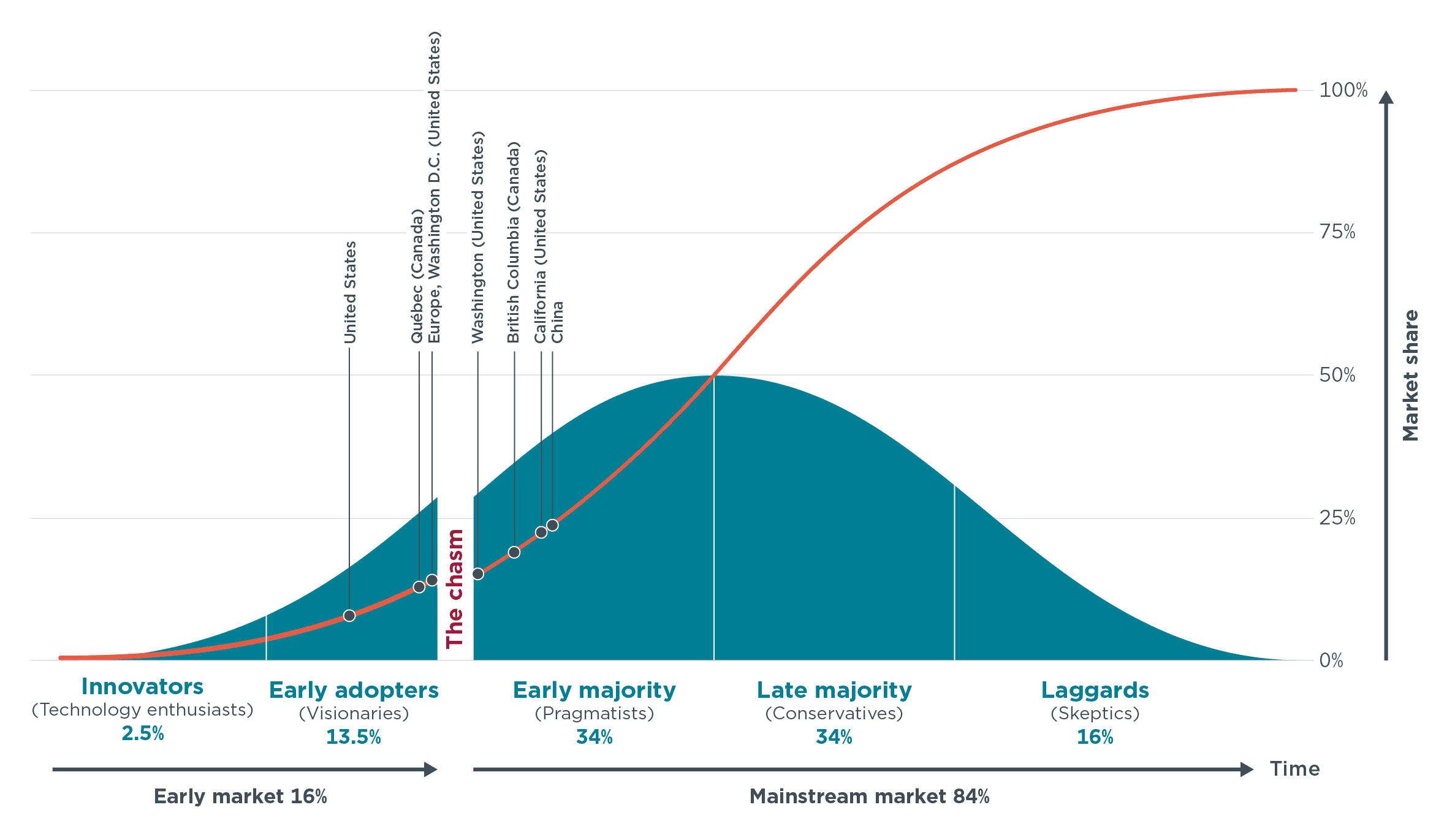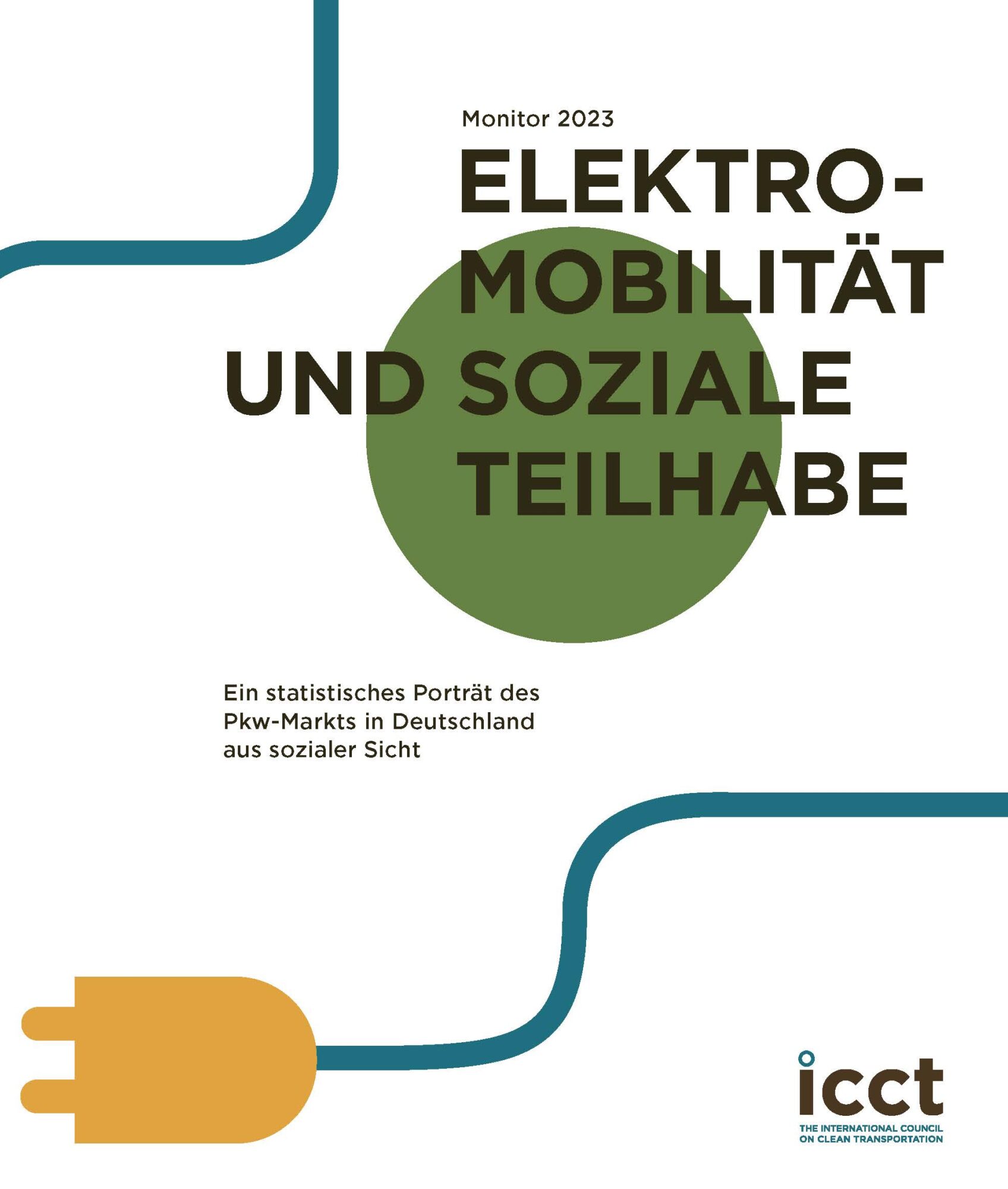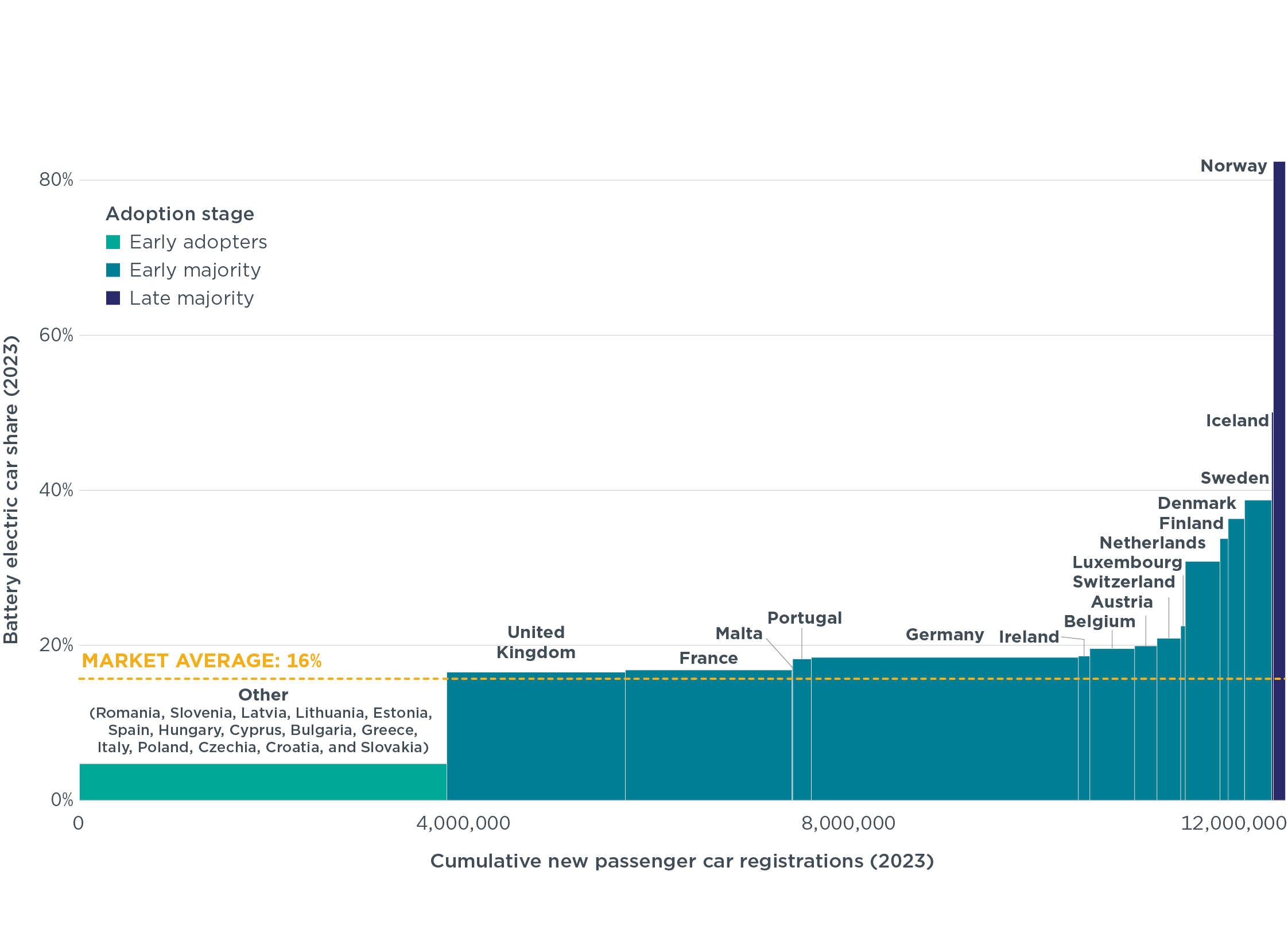Blog
Moving past the early market: How to get battery electric vehicles to the mainstream
It usually takes time for new technologies to gain widespread acceptance. According to Everett M. Rogers’ Technology Adoption Life Cycle model, new technologies follow a five-stage diffusion path that starts with tech-savvy, often more wealthy “innovators” and ends with “laggards.” We saw this with radios, cable TV, and personal computers, and now we’re seeing it with battery electric vehicles (BEVs).
Between the consumers in the early market who embrace innovations quickly and those who hesitate lies a “chasm” that Geoffrey Moore identified as the most critical point for the successful diffusion of new technologies. In Europe now, the adoption of BEVs is right around the chasm, and that’s why the key enabling policies we’ll discuss below are so critical.
We’ll start with a bit of context. In Europe, the total number of BEVs registered in the first half of 2024 was just over 954,000, a 1.6% increase compared with the same period in 2023. (Here Europe covers the 27 European Union [EU] Member States, Iceland, Norway, Switzerland, and the United Kingdom.) The EU-27 alone had 1.3% growth rate in the first half of 2024 compared with the first half of 2023. The BEV share of all cars registered in Europe reached 13.9% in the first half of 2024, almost the same as the 14.2% in the first half of 2023 (in the EU-27 alone it was 12.5% for first half 2024 versus 12.9% for first half of 2023).
Still, the BEV share of all new registrations decreased in 16 out of our 31 European countries from the first half of 2023 to the first half of 2024. Of the three largest European passenger car markets by new registrations, Germany’s BEV share decreased by 3 percentage points, France’s increased by almost 2 percentage points, and in the United Kingdom, it increased slightly by half a percentage point. Malta, Denmark, and Belgium saw the largest increases in new registration shares, by 15, 14, and 8 percentage points, respectively, in the first half of 2024 compared with the same period in 2023.
Because the European markets are developing at different rates, some skepticism about the future of BEVs has emerged in media coverage in various regions, including Germany and the United Kingdom. We’ve seen such reactions to other innovations in the past, though. So, let’s use the Rogers model to put today’s BEV trends into perspective.
We’ll use full-year figures for 2023 to avoid the influence of any potential seasonal peaks. In the Technology Adoption Life Cycle model, market uptake follows a predictable pattern called an S-curve, as shown in Figure 1. The early market—innovators and early adopters—comprises about 16% of targeted consumers compared with the other 84% of the market.
We looked at the adoption of BEVs through this same lens in a 2016 ICCT report. Fast forward to 2023, and we see that China is leading among large markets with a 24% share for BEVs among new car registrations. That means that BEVs in China are reaching many of the early majority consumers in the mainstream market; the same is true in the State of California in the United States. Europe’s BEV share is at almost 16%, approaching the mainstream, and the United States overall has an 8% sales share, which means BEVs are still being purchased only by early adopters. However, in some regional markets in the United States and Canada, including Washington, D.C. and Québec, BEVs are moving toward the mainstream, and in Washington state and British Columbia the market crossed the chasm in 2023.

Fifteen of our 31 European countries are in the early adopter stage, and the other 16 have already transitioned to the early and late majority (Figure 2). While the United Kingdom, France, Malta, Portugal, Germany, and Ireland are just beginning to attract early majority consumers, Scandinavian countries are leading with Norway and Iceland in the late majority stage.
Figure 2. Total new passenger car registrations and share of battery electric cars in 31 European countries in 2023
Source: ACEA – European Automobile Manufacturers Association
So, how have some leading BEV markets crossed the chasm? First and foremost, regulations that require car manufacturers to increase BEV supply are key. Establishing sales goals well in advance can guide car manufacturers to focus on their key strengths: managing costs to stay competitive and marketing to reach a larger customer base. Such binding regulations have been adopted in the European Union, the United Kingdom, Canada, the Canadian provinces of British Columbia and Québec, and some U.S. states, based on California’s regulation. The design of these regulations matters. In the European Union, there are no annual targets but rather stepwise targets with 5 years in between. Slow BEV registration growth in 2023 and 2024 is certainly connected to the fact that these years lie in an inter-target period.
Could governments implement additional supporting policies? Indeed, doing so would help reach an even larger share of the mainstream market. For example, California awards car manufacturers “environmental justice credits” when selling BEVs below the suggested retail price or selling them to community-based zero-emission vehicle programs (e.g., car sharing, ridesharing, ride-hailing, and on-demand service programs) targeted at communities with high poverty rates.
Another example is France’s social leasing program, implemented in January and February 2023. It provided new and used BEV leases at affordable rates for a minimum of 3 years. To qualify, individuals had to have an annual reference tax income of not more than €15,400 per person and demonstrate car dependency by either traveling over 8,000 km annually for work or living more than 15 km away from their workplace. The lease costs ranged from €40 to €150 per month, which catered to different consumer needs across various vehicle segments. The program exceeded expectations by receiving over 90,000 applications and accepting 50,000; that far surpassed the initial target of 20,000 to 25,000. The initial findings, shared by the Directorate-General for Energy and Climate (DGEC), indicate the program effectively reached new consumer groups, particularly those with lower incomes and younger individuals. Among the first 25,000 beneficiaries, 40% belonged to the three lowest income brackets. The average age of these beneficiaries was about 40, which is nine years younger than the average age of new BEV buyers in France in 2023.
According to Moore, crossing the chasm involves winning over the mainstream market by targeting the early majority first. Those folks are open to new technology but hesitate until it’s proven effective by others like themselves. They’re also more price-sensitive than early market individuals. For this group, providing complete solutions instead of bare technologies (the BEV) and building trust in the new technology (an ecosystem) are crucial. An example is Tesla, which built a network of fast-charging stations alongside its BEV sales to cater to consumer concerns about access to rapid and reliable charging.
Once regulations increasing the supply of a wide range of BEVs are in place, and the innovators and early adopters have been won over, there are many other measures to be implemented to extend BEV adoption to the early majority, late majority, and laggards. These include, but are not limited to, policies enhancing the supply of affordable BEVs, transparent and fair pricing for charging infrastructure, grid integration, improving battery storage and performance, and educating consumers about the societal, environmental, and economic benefits of BEVs.
Authors
Related Publications

Der ICCT-Monitor „Elektromobilität und soziale Teilhabe“ analysiert die Entwicklung des Pkw-Markts in Deutschland aus sozialer Sicht.



